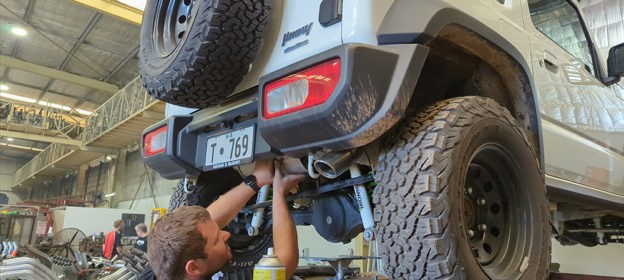
What’s the difference between a DPF and a CAT?
Catalytic converters (cats) and Diesel Particulate Filters (DPFs) are both parts of a car exhaust system. They have some similarities, so it’s understandable that there can be a bit of confusion around what exactly the difference between them is. Today, we’ll be running you through the similarities and differences between the two.
Similarities between cats and DPFs
Let’s start with what they have in common.
Both Cats and DPFs are emissions devices built into car exhaust systems to reduce the amount of air pollution from the engine that is released into the atmosphere. Modern environmental laws have established strict requirements around the emissions produced by vehicles, and cats and DPFs both work to ensure that your vehicle’s exhaust system is meeting these requirements.
Cats and DPFs both work in part by using a ceramic or metallic core known as a monolith, which exhaust gas passes through on its way from the exhaust manifold to the muffler and out into the world. Most cats and DPFs have a ceramic monolith, as they are cheaper than the metal alternatives. However, this ceramic core can be physically damaged if it impacts with obstacles like flying stones or speed bumps taken too quickly. It is also vulnerable to extreme temperature change. Manta uses high flow metallic substrates in all our exhaust systems, as the material is much more resilient to damage than the ceramic substrates found in OEM cats.
Differences
It’s about there that the similarities end. While cats and DPFs both work to reduce air pollution produced by your vehicle and use a ceramic monolith to do so, the ways in which they work and their general functions are very different.
What type of car uses a DPF or a cat?
The biggest difference between DPFs and cats is probably the most obvious: the ‘D’ in DPF stands for ‘diesel’, so DPFs are only found in diesel powered vehicles. The reason for this is that diesel and petrol engines produce different types of emissions. Compared to petrol, diesel is denser, contains more carbon and has a higher boiling point than petrol does, meaning that diesel engines are more likely to produce a sooty substance than petrol engines. This sooty substance is known as Diesel Particulate Matter (DPM), and it requires a DPF to keep it from leaving the car exhaust system and entering the atmosphere.
While DPFs are only found in diesel powered vehicles, cats aren’t just for petrol powered ones. Both modern diesel and petrol powered cars use cats. In some modern diesel cars, the cat and DPF are contained in one unit, while others keep the two parts separate.
What are they for and how do they work?
Cats are used to convert dangerous gases produced by the engine into less harmful ones, and does so by causing a chemical reaction. Inside a cat, carbon monoxide, hydrocarbons and nitrogen oxides are converted into nitrogen, carbon dioxide (CO2) and water. Oxygen is removed from the nitrogen oxide in a process called reduction and is added to carbon monoxide to create CO2 in a process called oxidation. Unburnt hydrocarbons are turned into CO2 and water in another oxidation process. This results in far less harmful gases leaving the cat.
While cats change the chemical composition of the gas, DPFs are simply a filter for Diesel Particulate Matter. Gas flows through the exhaust pipes from the cat or exhaust manifold into the DPF, which then collects particulate matter and stores it. Because the sooty substance isn’t going anywhere, it builds up. The DPF is designed to periodically ‘regenerate’ – a process in which the particles, which are mostly carbon, are burnt. Each time regeneration occurs, however, a small amount of ash is left behind, which can in turn build up to the point that the DPF gets blocked and requires replacing.
Should you replace a cat or DPF?
Cats are considered a flow-through device that’s part of the exhaust system and so should last the lifetime of your vehicle. However, it is worth noting that, as mentioned above, the cat’s ceramic monolith can break if exposed to heavy impact. The ceramic core can sometimes also be covered in oil from the exhaust manifest, which creates a black coating that’s difficult to remove and prevents the monolith from working. In these cases, the cat core must be replaced for the cat to function properly.
A DPF, as purely a filter and containment device, is considered a service item that will require replacing. The regeneration process occurs every 500km or so, and the DPF is designed to have a lifespan of around 250,000km. Very few last this long, however, with some needing replacement at as little as 100,000km. You can extend the time between replacements by making sure you regularly drive at speeds high enough and distances long enough to meet the regeneration process requirements and by using the right oil.
Performance exhausts for cat-equipped vehicles can either be a cat back system, or a full system that incorporates a replacement, high flow cat. But while cats can be replaced with a high flow version, there is no such thing are a high flow DPF, unless you increase the size of the unit. This is generally not recommended as it can cause issues in the regeneration function, and there is not always room underneath the vehicle for this larger unit. For this reason, Manta exhausts for vehicles equipped with a DPF typically run from the DPF back.
Up your game with a performance exhaust system
Whether your vehicle’s petrol or diesel powered, you now know all you need to understand the difference between cats and DPFs and their role in your exhaust system. While you’re here, check out our wide range of performance exhaust systems to add some power, sound and visual appeal to your car today.
